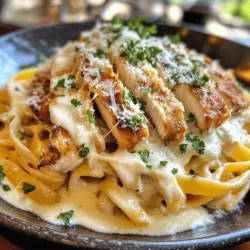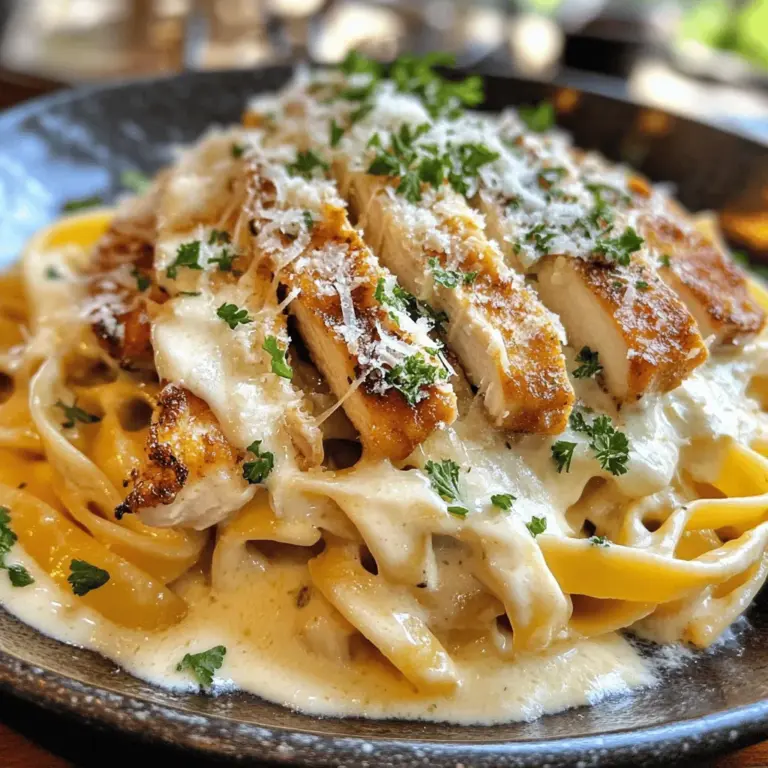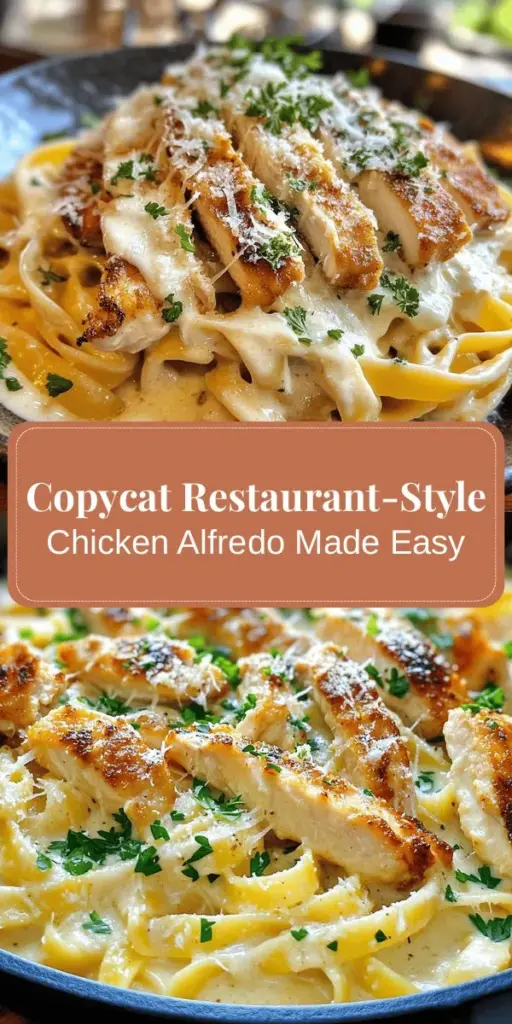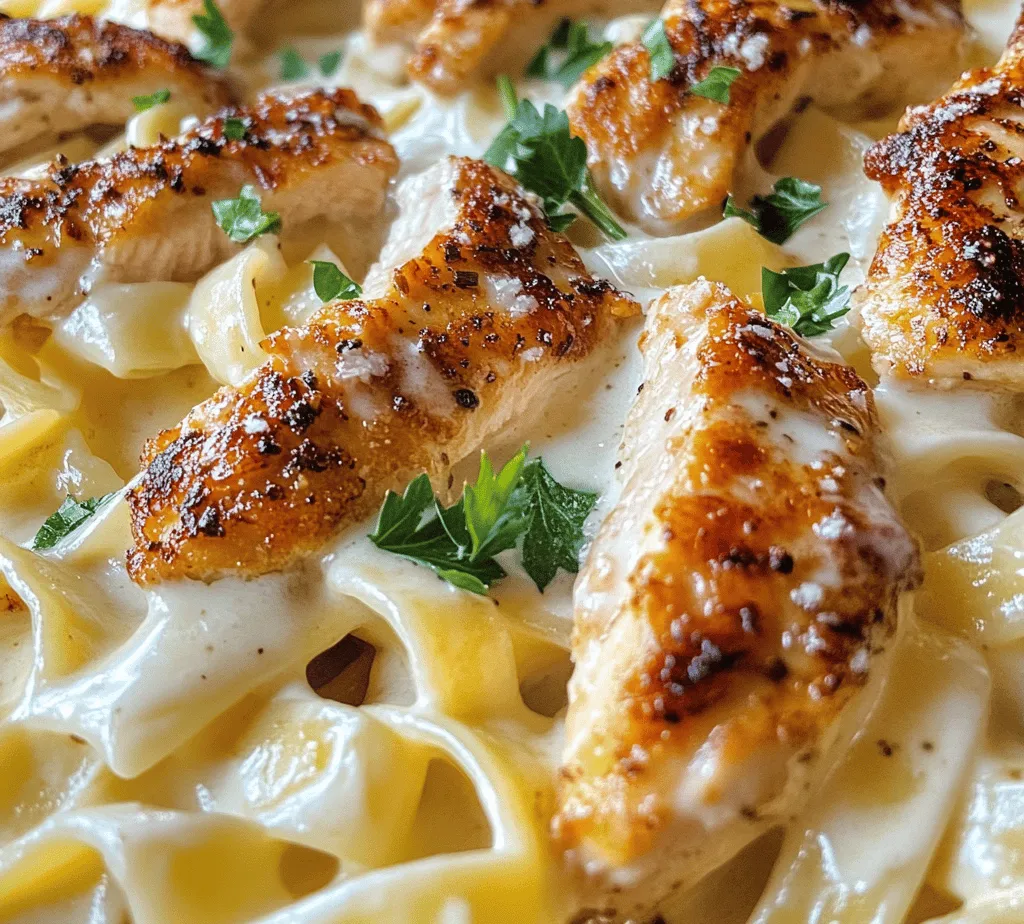Introduction
Chicken Alfredo is a culinary classic that has graced the menus of countless Italian restaurants and family dining establishments. This creamy pasta dish, typically made with fettuccine, chicken, and a rich Alfredo sauce, has captured the hearts and taste buds of food lovers everywhere. Why is this dish so beloved? Its decadent creaminess, combined with savory chicken and the delightful texture of fresh pasta, makes it a comforting choice for any occasion.
Recreating restaurant favorites at home not only saves money but also allows you to customize the flavors and ingredients to suit your preferences. Whether you’re preparing a special dinner for family or a gathering with friends, making your own Chicken Alfredo can elevate any meal from ordinary to extraordinary.
In this comprehensive guide, we’ll walk you through the steps to create the ultimate copycat restaurant-style Chicken Alfredo that rivals your favorite dining spots. This dish is not only easy to prepare, but it also brings the gourmet experience right into your kitchen. Get ready to impress your loved ones with a creamy, flavorful pasta dish that is sure to become a family favorite.
Understanding Chicken Alfredo
History and Origins of Fettuccine Alfredo
Fettuccine Alfredo has an interesting history that dates back to the early 20th century. The dish was invented by Alfredo di Lelio, an Italian restaurateur who wanted to create a meal that would appeal to his pregnant wife. He combined fettuccine pasta with butter and Parmesan cheese, creating a simple yet indulgent dish that quickly gained popularity.
As the dish made its way to America, it underwent a transformation, with the addition of cream, chicken, and various seasonings, leading to the Chicken Alfredo we know today. The creamy sauce and tender chicken became staples in Italian-American cuisine, making it a go-to dish for many. This rich history adds a layer of depth to the experience of making Chicken Alfredo at home, as you’re not just preparing a meal; you’re also embracing a part of culinary tradition.
Why Chicken Alfredo is a Beloved Dish
There are several reasons why Chicken Alfredo remains a favorite among diners. First and foremost, its creamy texture and rich flavors create a satisfying experience that appeals to the senses. The dish strikes a perfect balance between comfort food and gourmet dining, making it suitable for casual family dinners and special occasions alike.
Moreover, Chicken Alfredo is highly versatile. You can easily adapt it to suit different dietary preferences or ingredient availability. For instance, you can switch out the chicken for shrimp, add vegetables for a healthier twist, or even create a vegetarian version by omitting meat altogether. This flexibility ensures that Chicken Alfredo can be enjoyed by everyone, regardless of their dietary restrictions.
The Role of Creaminess and Flavors in the Dish
The allure of Chicken Alfredo lies in its luxurious creaminess, which provides a delightful mouthfeel that coats each strand of fettuccine beautifully. The combination of heavy cream and Parmesan cheese creates a sauce that is both rich and savory, while the garlic adds aromatic depth to the mix. These flavors meld together, creating a comforting and satisfying dish that is hard to resist.
In addition to the creaminess, the seasoning plays a crucial role in elevating the dish. Italian seasoning, which often includes herbs like basil, oregano, and thyme, enhances the overall flavor profile, giving it that authentic Italian taste. Fresh parsley is often added as a garnish, providing a pop of color and a fresh note that balances out the richness of the sauce.
Ingredients Breakdown
To create the ultimate Chicken Alfredo, you’ll need to gather a selection of high-quality ingredients. Using fresh, premium components will significantly enhance the dish’s flavor and texture. Let’s take a closer look at each ingredient and understand its role in this classic recipe.
Fettuccine Pasta
Fettuccine is the traditional pasta choice for Alfredo dishes. Its flat, thick shape allows it to hold onto the creamy sauce exceptionally well, resulting in a perfect pasta-to-sauce ratio in every bite. While you can use other pasta shapes, such as penne or rigatoni, fettuccine remains the classic choice for an authentic experience.
Chicken
The chicken serves as the primary protein source in this dish. For best results, opt for boneless, skinless chicken breasts or thighs, as they cook quickly and remain tender. The chicken adds not only protein but also enhances the flavor profile of the dish, making it more filling and satisfying. Grilled or sautéed chicken works well, and you can season it with salt and pepper before cooking for added taste.
Olive Oil
Olive oil is the ideal cooking medium for this recipe. It not only helps to cook the chicken but also infuses the dish with its healthy fats and a subtle flavor. Extra virgin olive oil is the best option, as it offers a richer taste and more health benefits compared to regular olive oil.
Garlic
Garlic is a key aromatic ingredient that adds depth and flavor to the Alfredo sauce. When cooked, garlic becomes tender and sweet, balancing the richness of the cream and cheese. For the best results, use fresh garlic cloves and mince them finely to release their full flavor potential.
Heavy Cream
Heavy cream is the star of the Alfredo sauce, providing the luxurious texture that makes this dish so indulgent. It’s essential for achieving that creamy consistency that coats the fettuccine beautifully. When heated, heavy cream thickens and creates a velvety sauce that is both rich and satisfying.
Parmesan Cheese
Parmesan cheese is another cornerstone of Chicken Alfredo. It contributes a sharp, salty flavor that enhances the creaminess of the sauce. For the best results, use freshly grated Parmesan cheese rather than pre-grated varieties, as it melts better and provides a fresher taste.
Italian Seasoning
Italian seasoning is a blend of dried herbs that adds complexity to the dish. Commonly found in Italian cuisine, it typically includes basil, oregano, thyme, and rosemary. This blend of flavors will elevate your Alfredo sauce and bring authenticity to your homemade dish.
Fresh Parsley
Finally, fresh parsley is used as a garnish to add color and a hint of freshness to the finished dish. Not only does it enhance the visual appeal, but it also provides a bright contrast to the rich flavors of the Chicken Alfredo. A sprinkle of chopped parsley right before serving will make your dish look as good as it tastes.
As we delve into the preparation of this delicious meal, remember that the quality of your ingredients will directly impact the final outcome. By selecting fresh, high-quality components, you set the stage for an extraordinary dining experience that captures the essence of restaurant-style Chicken Alfredo.
In the following sections, we will guide you through the step-by-step instructions to prepare this delightful dish, ensuring you achieve the perfect balance of flavors and textures every time. So, let’s get ready to cook!
Step-by-Step Cooking Instructions
Creating the ultimate copycat restaurant-style Chicken Alfredo is about precision and timing. Follow these detailed instructions to ensure your dish comes out perfectly every time.
Cooking the Fettuccine
To achieve the ideal al dente texture for your fettuccine, start by filling a large pot with water and adding a generous pinch of salt. Bring the water to a rolling boil before adding the pasta. The salt not only enhances the flavor of the pasta but also helps to elevate the overall taste of your dish.
Cook the fettuccine according to the package instructions, usually around 10-12 minutes, but start checking for doneness a minute or two before the suggested time. You want the pasta to be tender yet firm to the bite. Once cooked, reserve about a cup of the pasta water and then drain the fettuccine in a colander. Toss it lightly with a drizzle of olive oil to prevent sticking and set it aside while you prepare the chicken and sauce.
Searing the Chicken
For the chicken, use boneless, skinless chicken breasts for the best results. Pat them dry with paper towels to ensure a good sear. Season both sides generously with salt and pepper. Heat a large skillet over medium-high heat and add a tablespoon of olive oil. Once the oil is shimmering, carefully place the chicken breasts in the skillet.
Cook the chicken for about 6-7 minutes on each side, or until it’s golden brown and reaches an internal temperature of 165°F. This searing process locks in the juices, ensuring tenderness and flavor. Once cooked, transfer the chicken to a cutting board and let it rest for a few minutes before slicing it into strips.
Sautéing Garlic
Garlic is a key ingredient in Chicken Alfredo, and timing is crucial for releasing its flavor without burning it. In the same skillet used for the chicken (don’t wipe it clean; the leftover oil will add flavor), reduce the heat to medium and add minced garlic. Sauté the garlic for about 30 seconds or until fragrant, stirring continuously to prevent it from browning. Once the garlic is aromatic, it’s time to move on to the sauce.
Creating the Alfredo Sauce
For a luxuriously creamy Alfredo sauce, you’ll need heavy cream, unsalted butter, and freshly grated Parmesan cheese. Pour the heavy cream into the skillet with the sautéed garlic. Allow it to simmer gently for about 2-3 minutes, stirring frequently.
Next, add the butter, which will melt into the cream, creating a rich base. Gradually incorporate the Parmesan cheese, whisking continuously to avoid lumps. If the sauce appears too thick, you can add a bit of the reserved pasta water until you achieve your desired consistency. Taste and adjust seasoning with salt and freshly cracked black pepper.
Combining the Ingredients
Once your sauce is ready, it’s time to bring everything together. Add the cooked fettuccine to the skillet, tossing it gently in the creamy sauce to ensure every strand is coated evenly. If the sauce seems too thick, add more reserved pasta water, a little at a time, until you reach a luscious, creamy consistency. Finally, add the sliced chicken on top, allowing it to warm through in the sauce.
Tips for Perfecting Your Chicken Alfredo
Adjusting the Sauce Thickness and Creaminess
If you prefer a thicker Alfredo sauce, reduce the amount of heavy cream or allow it to simmer longer to evaporate some of the liquid. For a creamier texture, consider adding more butter or cheese, or even a splash of cream cheese for extra richness.
Substitutions for Dietary Restrictions
For gluten-free options, substitute traditional fettuccine with gluten-free pasta varieties made from rice, quinoa, or chickpeas. If you’re looking for a dairy-free version, use coconut milk or cashew cream as a base and substitute nutritional yeast for Parmesan cheese to maintain a cheesy flavor.
Flavor Enhancements
Get creative with your Chicken Alfredo by adding sautéed vegetables such as spinach, broccoli, or mushrooms. You can also enhance the flavor profile by incorporating spices like nutmeg or red pepper flakes, which can add a subtle warmth to the dish.
Serving Suggestions
To elevate your Chicken Alfredo experience, consider pairing it with a fresh side salad drizzled with a light vinaigrette. Garlic bread or cheesy breadsticks also make excellent accompaniments, providing a delightful crunch to balance the creamy pasta.
For beverage pairings, a crisp white wine like Chardonnay complements the richness of the Alfredo sauce beautifully. If you prefer non-alcoholic options, try sparkling water with a slice of lemon or a refreshing iced tea.
When it comes to plating, presentation is key. Use a large, shallow bowl or plate to serve the Chicken Alfredo, twirling the fettuccine into a nest shape in the center. Top with sliced chicken, a sprinkle of grated Parmesan, and a few fresh herbs like parsley or basil for a pop of color.
Storing and Reheating Leftovers
Best Practices for Storing Chicken Alfredo
If you have leftovers, store them in an airtight container in the refrigerator. It’s best to consume them within 3-4 days for optimal freshness. When storing, consider keeping the pasta and sauce separate if possible, as this helps maintain the texture of the fettuccine.
Tips for Reheating Without Compromising Texture and Flavor
To reheat your Chicken Alfredo, gently warm it on the stovetop over low heat. Add a splash of milk or cream to the pan to help loosen the sauce, stirring continuously until heated through. Avoid using the microwave, as it can cause the pasta to become rubbery and the sauce to separate.
Conclusion
Making restaurant-style Chicken Alfredo at home is not only achievable but also incredibly rewarding. With a few carefully executed steps and a willingness to customize the dish to your personal taste, you can recreate this classic Italian favorite in your kitchen. The joy of cooking and sharing a delicious meal with loved ones is unmatched—so gather your ingredients, follow the recipe, and savor the delightful results. Whether you choose to stick with the traditional flavors or experiment with new additions, this Chicken Alfredo will surely impress everyone at your table. Enjoy the satisfaction that comes from creating a restaurant-quality dish right at home!



